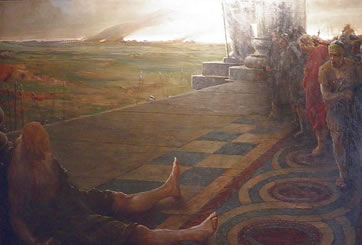The Nero’s doubles

On 9 June 68 AD, Nero Lucius Domitius Ahenobarbus died. He was the last emperor of the Julio-claudian dynasty.
In 67, taken by repressive madness, Nero induced General Domitius Corbulo to suicide and ordered Servius Sulpicius Galba to commit suicide too. But the Governor of Spain instead of committing suicide declared his allegiance to Rome and to the Senate and did not recognize the authority of Nero. Lucius Clodius Macer followed his example in Africa and blocked shipments of wheat to Rome. Meanwhile Galba, promising large sums of money, attracted the Praetorians to his side; at that point the Senate deposed Nero.
Nero fled from his palace where he was left alone and took refuge in the villa that the freedman Faonte had in the countryside in the ager nomentanus; took a short sword and pushed him against the chest but not having the courage to push down it so the secretary a libellis (petitions) Epaphroditosdid help to him.
The Senate decreed the damnatio memoriae, but allow the funeral privately. Then Faonte called Atte which went to the villa with Egogle and Alexandria, the two nurses who had grown along Nero with aunt Domitia Lepida. They will be the last ones to take care of his body; Nero was cremated, wrapped in white blankets woven of gold used by him to the latest Kalends of January.
The three women took the ashes of Nero to the Domitium Mausoleum, on the Garden Hill where everyone could see from Campus Martius, and overthrew in a porphyry urn surmounted by a marble altar of Luni. Nero was’nt buried among the others Augustus, he refused was in eternal rest near Messalina, his cousin and daughter of his beloved aunt who had raised, Domitia Lepida.
Suetonius says that many mourned the death of Nero and for months on his grave were placed flowers, as well as in the Foro were exposed his toga-clad statues and hung some of his edicts.
There were those who didn't want to believe he died but just hidden somewhere waiting to return; this rumor that circulated to Rome favored the appearance of impostors of some of these and their attempts to get something historians tell us.
Tacitus relates that a Nero appeared in 69 a.d., in the province of Asia, perhaps it was a slave of Pontus or a Italian freedman who resembles to Nero and also knew how to play the harp and sing. He managed to gather under him a group of deserters and get a ship in which he sailed to Rome but was slammed by a storm on the island of Kythnos, Cyclades, Greece. In the island joined a group of legionnaires under license and with the threat by killing those who refused; also attempted to convince the Centurion who was bringing in Rome the right hands, promises of friendship of the Syrian army. The Centurion was not believed and left secretly the island; the news of this impostor reached Galba who commissioned Calpurnius Asprenas to solve the problem. Asprenas sent two triremes that stayed in the game of the impostor and embarked him for Egypt where he wanted to go. The impostor was then isolated and killed and his body sent to Rome.
There were other doubles even from a distance of many years since the death of Emperor Nero; according to historian Dio Cassius one appeared when he was Emperor Titus, and managed to form a small army with whom he wanted, helped by the Parties, attempting to replace Tito. He made the mistake of asking to Artabanus, King of Parthia, a counterpart for having returned the Armenia: the Parthians killed him.
The legend that Nero was alive still circulated in the 4th century, so much so that St. Augustine the recalls as the Nero redivivus legend.
by M.L. ©ALL RIGHTS RESERVED (Ed 1.0 - 22/05/2015)






